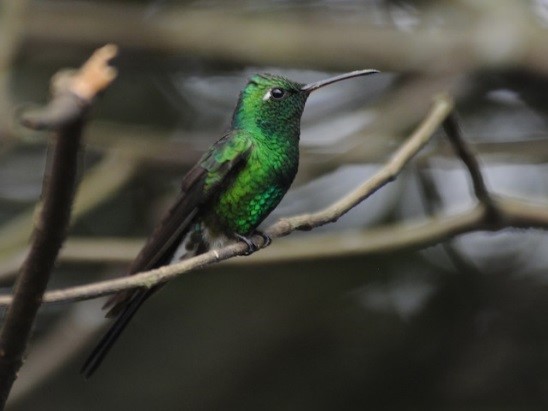Birdfinding.info ⇒ Common, widespread, and easy to find throughout Cuba and the northern Bahamas, where it is the predominant hummingbird. Present at all the frequently visited Cuban sites. On Grand Bahama, the Garden of the Groves in Freeport is a reliable site.
Cuban Emerald
Chlorostilbon ricordii
Endemic to Cuba, its satellite islands, and the northern Bahamas (Grand Bahama, Abaco, Andros, and adjacent cays). Thrives in most habitats, from forest to scrub and gardens.
There have been many reports of vagrant Cuban Emeralds along the east coast of Florida, but apparently none yet documented with a photograph.
Identification
Male is a thin, glittering green hummingbird with a long, deeply forked tail and a straight or slightly decurved bill. There is nothing similar in its range.

Cuban Emerald, male showing white post-ocular spot and forked tail. (La Guira National Park; January 7, 2015.) © Alain Sylvain
Differs from males of other West Indian emerald species in having a bright-white post-ocular spot, white vent, and coppery rump and uppertail.
The bill is black above and red or reddish below, but often appears all-black.
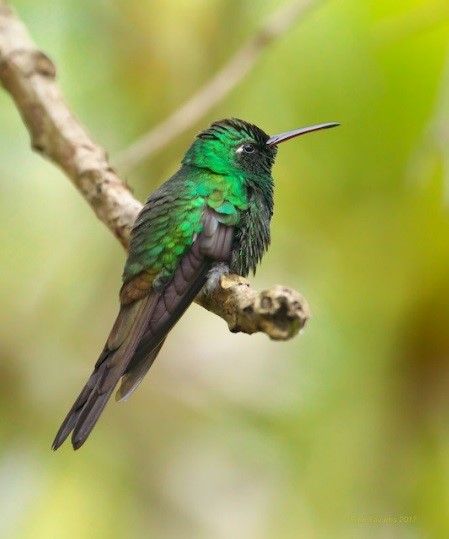
Cuban Emerald, male showing coppery rump and uppertail. (Topes de Collantes National Park, Cuba; February 17, 2017.) © Paul Tavares
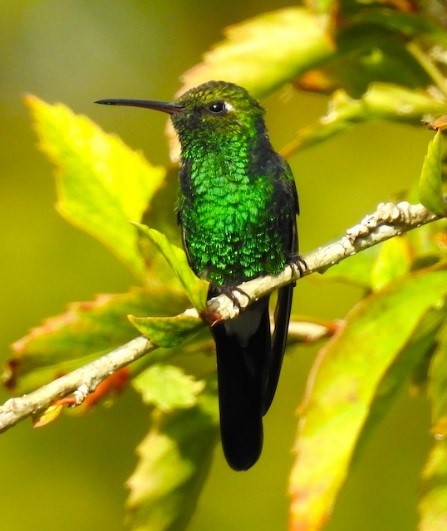
Cuban Emerald, male. (Garden of the Groves, Grand Bahama; February 2, 2018.) © Erika Gates

Cuban Emerald, male showing white vent and reddish underside of the bill. (Topes de Collantes National Park, Cuba; February 17, 2017.) © Paul Tavares
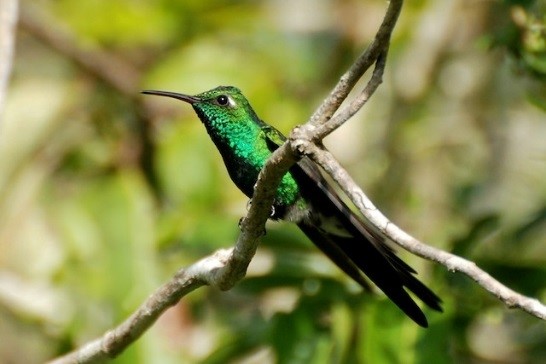
Cuban Emerald, male. (Cabo Corrientes, Peninsula de Guanahacabibes National Park, Cuba; November 8, 2010.) © Marilyn Henry
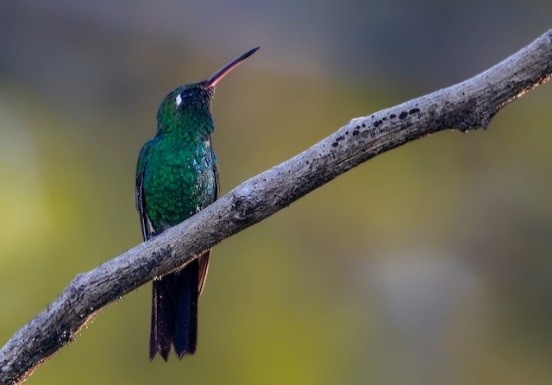
Cuban Emerald, male showing bright white post-ocular spot. (Playa Pesquero, Holguín, Cuba; February 25, 2018.) © Suzanne Labbé

Cuban Emerald, male stretching and showing red on bill. (Garden of the Groves, Grand Bahama; February 27, 2017.) © Erika Gates
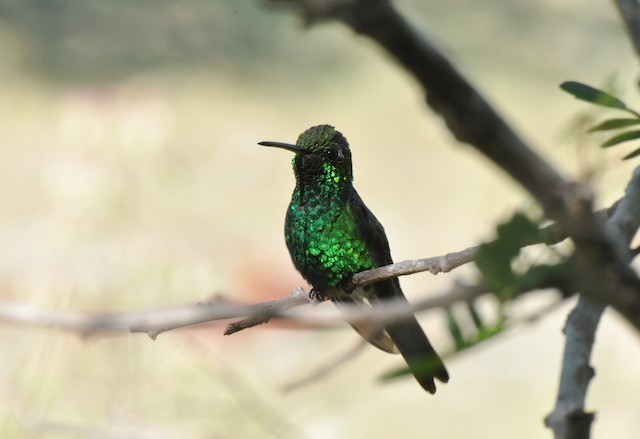
Cuban Emerald, male. (Quihones, Holguín, Cuba; January 13, 2015.) © James Thompson
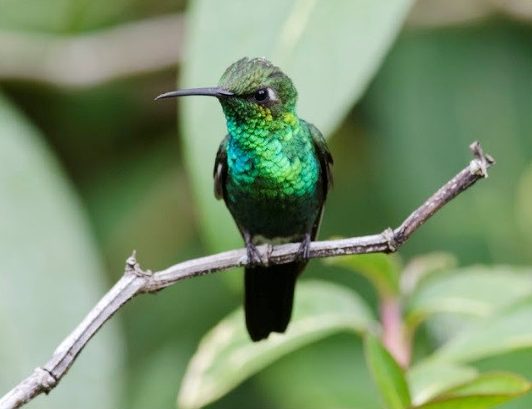
Cuban Emerald, male showing unusually strong curvature in the bill. (Topes de Collante National Park, Cuba; February 18, 2015.) © Joshua D. Vandermeulen
Female has a deeply notched, all-dark or coppery tail, whitish underparts with green sides, a blackish eyestripe and white post-ocular streak. Potentially confused with other small female hummingbirds.
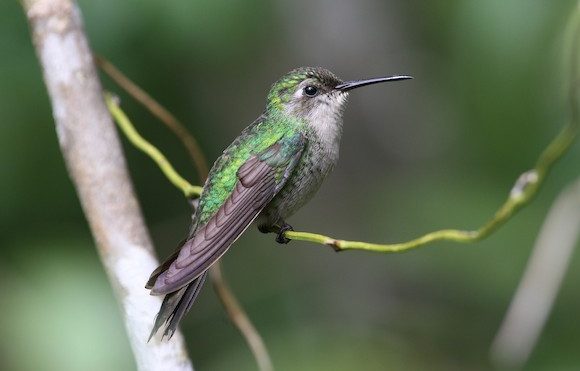
Cuban Emerald, female. (Marsh Harbour, Abaco, Bahamas; January 11, 2013.) © Christoph Moning
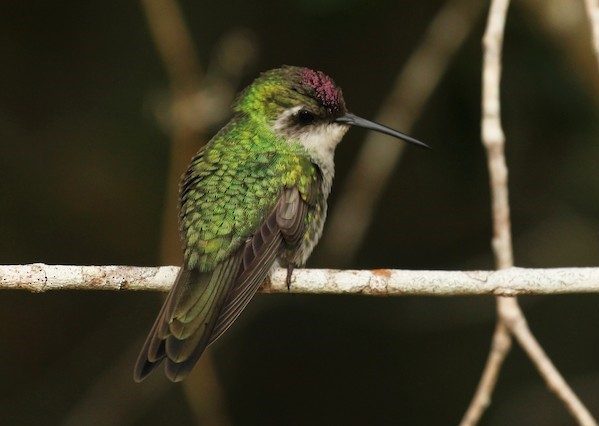
Cuban Emerald, female, apparently with pollen on its crown. (Bahama Palm Shores, Abaco, Bahamas; December 9, 2015.) © Jason Estep
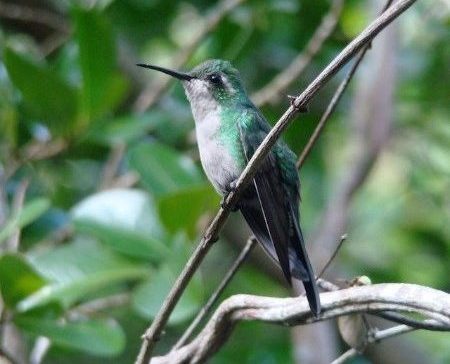
Cuban Emerald, female. (Cabo Corrientes, Peninsula de Guanahacabibes National Park, Cuba; November 8, 2010.) © Joe Sebastiani

Cuban Emerald, female showing notched tail with coppery sheen. (Guantánamo Bay, Cuba; January 31, 2018.) © Wayne Fidler
Cf. Ruby-throated Hummingbird. The most likely source of confusion with female Cuban Emerald, both within its natural range and as a potential vagrant to the U.S., is the female Ruby-throated Hummingbird. The female emerald is best recognized by its forked tail with a coppery upperside and rump. The Ruby-throated is slightly larger-bodied, and has a shorter, squarer, white-tipped tail, and dots on its throat.
Notes
Polytypic species consisting of two recognized subspecies: ricordii of Cuba and aeneoviridis of the Bahamas.
References
Bündgen, R., and G.M. Kirwan. 2018. Cuban Emerald (Chlorostilbon ricordii). In Handbook of the Birds of the World Alive (J. del Hoyo, A. Elliott, J. Sargatal, D.A. Christie, and E. de Juana, eds.). Lynx Edicions, Barcelona. https://www.hbw.com/node/55439. (Accessed November 1, 2018.)
eBird. 2018. eBird: An online database of bird distribution and abundance. Cornell Lab of Ornithology, Ithaca, N.Y. http://www.ebird.org. (Accessed November 1, 2018.)
Fogden, M., M. Taylor, and S.L. Williamson. 2014. Hummingbirds: A Life-size Guide to Every Species. HarperCollins, New York.
Garrido, O.H, and A. Kirkconnell. 2000. Field Guide to the Birds of Cuba. Cornell University Press, Ithaca, N.Y.
Howell, S.N.G., I. Lewington, and W. Russell. 2014. Rare Birds of North America. Princeton University Press, Princeton, N.J.
Raffaele, H., J. Wiley, O. Garrido, A. Keith, and J. Raffaele. 1998. A Guide to the Birds of the West Indies. Princeton University Press, Princeton, N.J.
